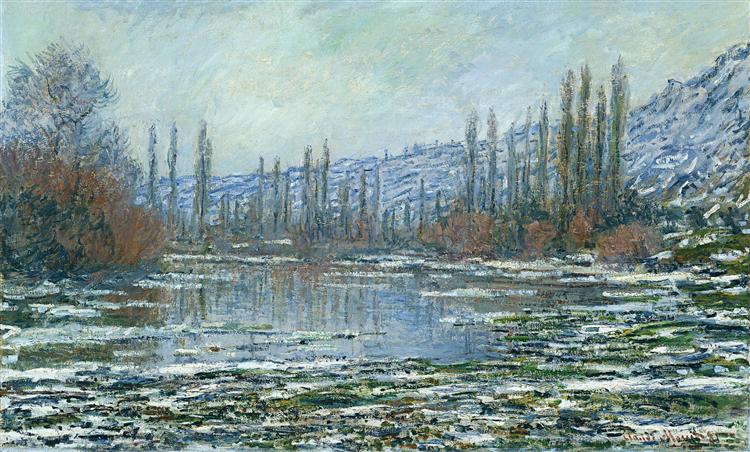Description
At the heart of the Impressionist movement, Claude Monet stands as a master of depicting light and atmosphere, and his work The Thaw at Vetheuil (1881) is a magnificent manifestation of this skill. In this canvas, Monet captures a singular moment in nature's transition, where winter slowly melts away to make way for spring. Offering a view of the Vetheuil region, the painting becomes a testament to the delicate balance between cold and heat, between water and ice.
The composition of the work is presented as a subtle dialogue between the cold tones of winter and the warm signs of the arrival of spring. Before us, a landscape that begins to strip itself of its frozen mantle. The river, partially thawed, flows with a serenity that invites the viewer to contemplate the magnitude of the seasonal change. The surface of the water, formed by a palette of blues and greyish hues, reflects the light of day, enriching the work with a vibrant luminosity that transports us to the fresh atmosphere of a spring morning. The loose and energetic brushstrokes that Monet uses provide a texture that captures the movement of water and air, fundamental elements of Impressionism.
The trees on the shore, stripped of their winter foliage, are rendered in an earthy brown hue, displaying dormant life that will soon blossom. The inclusion of elements such as the small boat and the barely hinted-at human figures give a sense of scale and everyday life to the landscape, reminding us that although nature is dominant, there is still room for human experience within it. The figures are almost ghost-like in the scene, underlining Monet’s focus on the natural environment rather than humanity itself. This approach is not uncommon in Monet’s work, who often preferred to let landscapes speak for themselves.
Monet, as a pioneer of Impressionism, succeeds in "The Thaw at Vetheuil" not only in capturing a moment in time, but also in encapsulating an emotion, a sense of renewal and hope. The technique of loose, rapid brushstrokes brings the scene to life, evoking the immediacy of the moment and allowing light to play across the surfaces, creating an atmosphere that is both spiritual and earthly.
It is interesting to note that this work, created in a period when Monet had already developed his characteristic style, is part of a series of landscapes that explore the same theme. In particular, the artist's interest in the play of light and colour on water, as well as his dedication to the representation of the natural environment, could place this work in dialogue with other contemporary pieces of his, such as Rouen Cathedral or Water Lilies, where the effects of light play a crucial role.
"The Thaw at Vetheuil" is therefore more than just a depiction of a landscape; it is a poetic study of transformation, of the seasons, of water, and of human sensitivity to nature. Through this work, Monet invites the viewer to experience the fleeting beauty and serenity found in moments of change, a theme that resonates deeply in his vast output and in the legacy of Impressionism.
KUADROS ©, a famous painting on your wall.
Hand-made oil painting reproductions, with the quality of professional artists and the distinctive seal of KUADROS ©.
Painting reproduction service with satisfaction guarantee. If you are not completely satisfied with the replica of your painting, we will refund 100% of your money.

